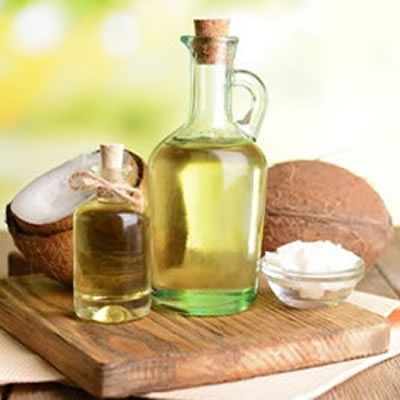
Coconut Oil
What is Coconut Oil?
Coconut oil is a colorless, edible oil from the kernel meat of coconuts, the fruit of the coconut palm tree (Cocos nucifera). Virgin coconut oil (VCO) is defined as the oil obtained from the fresh, mature kernel of coconuts by mechanical or natural means without the use of heat, chemical refining, bleaching, or odorizing, any of which would lead to alteration of the natural content of the oil.
- Refined, deodorized (neutralized, bleached, final steam deodorization)
- Refined (no steam treatment)
- White oil (higher free fatty acids)
- Industrial oil (crude oil, not edible without processing).1
Cold-pressed virgin coconut oil, or CPVCO, requires the same process as virgin coconut oil. No heat is used during extraction.
Origin
Since coconut has an ancient history of natural distribution, starting with ocean and waterway travel, and only subsequently through human interactions, the origin of coconut oil is largely debated. While coconut oil can be produced globally, the largest manufacturers are the Philippines, Indonesia, India, Sri Lanka, Mexico, Malaysia and Papua New Guinea.
Nutrition
The oil has the natural sweet taste of coconut and contains 92% of saturated fatty acids (in the form of triglycerides); most of these (about 70%) are medium-chain fatty acids (MCFAs).1
(The major fatty acid components of coconut oil are 49% lauric acid (C12:0) and 20% myristic acid (C14:0). Smaller amounts of secondary fatty acids include 8% palmitic acid (C16:0), 7% caprylic acid (C8:0), 5% capric acid (C10:0) and 3% stearic acid (C18:0).
The oil from coconuts has shown anti-diabetic and cholesterol-lowering properties in rat studies. “When 10ml/kg/day of VCO was administered to a diabetic experimental group, they showed a decrease of 33%, 44% and 53% (p < 0.01) decrease in blood glucose at the end of the 1st, 2nd and 3rd week, respectively. Serum total cholesterol, LDL, TGL (except HDL) of the experimental cholesterol group was significantly lower after the administration of 8ml/kg/day and 10ml/kg/day of virgin coconut oil for thirty days (p < 0.01). The results indicated 8 ml/kg/day and 10ml/kg/day of CPVCO reduced blood glucose and lipids via total cholesterol, low density lipoprotein and triglycerides to a significant level.”2
VCO has also been shown to have antimicrobial activity. Transmission electron microscopy (TEM) showed the disruption of both the cell membrane and the cytoplasm of cells exposed to 2 mg/mL of lauric acid.3 Changes in bacterial cell membrane integrity were confirmed for VCO and select fatty acids using Live/Dead staining.3
While coconut oil may have some health benefits, its high saturated fat content means that caution is required when developing new food products. The American Heart Association recommends restricting saturated fat intake to 6% or less of total daily calories.
Function
Coconut oil can be stored up to 10 months at ambient conditions.2
Baking with coconut oil contributes tenderness, moistness, and a smooth mouthfeel to finished products, and serves as a flavor enhancer of blended ingredients while contributing its own distinct flavor.4
Commercial production
There are a number of methods for extracting coconut oil from coconut meat. However, the most common method of extraction involves using copra or dried coconut meat and pressing out the oil.
There are also many methods for extracting it from the fresh coconut meat commonly called kernel meat. VCO is typically extracted using a wet process. Commercially, hydraulic presses are commonly used to remove coconut oil from the kernel. From here, the it is placed in a centrifuge to remove unwanted particles, precipitates, and water. Finally, a method of fermenting coconut meat can be used to extract it.
Application
Coconut oil is used in a number of applications – baked goods, infant formula, chocolate applications, and ice cream, as well as health and beauty products. As a food ingredient, it is often used as a trans-fat substitute, since it remains solid at temperatures below 76⁰F (25⁰C). For baking applications, coconut oil is often used as a butter, lard, or oil replacement.
Coconut oil may be used at a 1:1 substitution for fats in baking formulas.
When using unrefined or virgin coconut oil, the flavor and odor of coconut will be incorporated into your baked goods. Refined coconut oil may be used without imparting any change in flavor or odor.
FDA regulation
Coconut oil is GRAS (generally recognized as safe). Coconut oil derivatives, such as coconut butter, require additional scrutiny depending on their application. When declaring the health benefits of coconut oil, caution should be observed, as the FDA routinely rejects health claims related to coconut oil.5
References
- Krishna G., Raj G., Bhatnagar A.S., Kumar P., Chandrashekar P. Coconut oil: chemistry, production and its applications – a review. Indian Coconut Journal. July 2010; 73(3): 15-27..
- Arumugam M., Raman M., Eagappan K. Cold pressed virgin coconut oil from full fat coconut flakes a functional oil. International Journal of Pharmacy and Pharmaceutical Sciences. 2016.; 6(16):186-90.
- Shilling M., Matt L., Rubin E., Visitacion M.P., Haller N.A., Grey S.F., Woolverton C.J. Antimicrobial effects of virgin coconut oil and its medium-chain fatty acids on clostridium difficule.” Journal of Medicinal Food. Dec 2013;16(12):1079-85.
- Bakerpedia. Fat | Baking Ingredients. https://bakerpedia.com/ingredients/fat/. Accessed 16 August 2017.
- US Food and Drug Administration. Warning Letters. US Food and Drug Administration Home Page. http://www.fda.gov/ICECI/EnforcementActions/WarningLetters/ucm433444.htm Accessed 16 August 2017.

